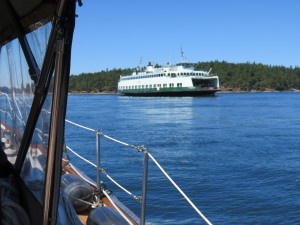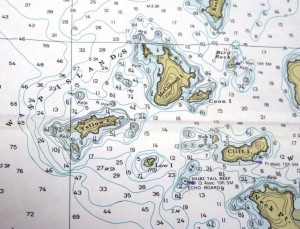An artist’s dream! Two friends and I signed up for a watercolor painting workshop held in the spring on Orcas Island. Each morning, our instructor taught us a specific technique before leading us on a fieldtrip to practice our new skill painting flowers. Our first destination? A Turtleback Mountain farm where we gathered in an orchard of cherry trees, bursting in pink and white blossoms. Daffodils waved in the wind at our feet. If we didn’t have an assignment to sketch the flowers, I think all of us would have chosen to paint the exquisite view of West Sound, its sparkling blue waters dotted with sailboats and other watercraft below us! The next day, we boarded a Deer Harbor charter boat to sample the charm of Yellow Island.
Photo courtesy of Washington State Fish & Wildlife Service
Wildflowers adorn this 11-acre island purchased by The Nature Conservancy. Its fragile ecosystem is situated north of the western entrance of Wasp Passage and southwest of Deer Harbor on Orcas Island. It is one of the Wasp Islands. You can spot Yellow Island from a Washington State ferry transiting Wasp Passage, if you ride the route that stops at both Orcas Island and Friday Harbor. Stand on the north side of the boat with binoculars or a camera with telephoto lens to see this dramatic springtime display
Washington State ferry in Wasp Passage
Better yet, join a group tour with a permit and visit this unique island. Its grasslands are unique in the Puget Sound lowlands, because there has been an absence of grazing. Because of this, an unusual diversity of native plants thrive here without being overrun by non-native species. Phil Green, the current full-time caretaker at the time of this post, tells visitors that 25% of all plant species indigenous to the San Juan archipelago are present on Yellow Island. Over 50 species of flowers flourish here, including the shooting star, Indian paintbrush, chocolate lily, camas, and stonecrop. And the prickly pear cactus—the single species native to western Washington—is the thorn among the flowers. Click here to hear a long-time caretaker of Yellow Island, Phil Green, give a talk about the island.
 Camas – Photo courtesy of Wikimedia Commons
Camas – Photo courtesy of Wikimedia Commons
Purchased in 1979 from Joe and Sally Hall. Yellow Island was the first major acquisition by the Washington Field Office of The Nature Conservancy. Sally wanted it to remain as when her parents, Lew and Elizabeth ‘Tib’ Dodd, homesteaded the island in 1947. After living in a tent for two years, they built a rustic cabin from driftwood and rock. Believing in self-sufficiency, they planted a small garden with a few fruit trees and grapevines, raising chickens and pigeons for meat. They left the rest of the island in its natural state. Today, their cabin is the caretaker’s home (with solar panels) and a pair of bronze memorial plaques honor their memory.
Caretaker’s cabin
The waters around Yellow Island are part of the San Juan Islands Marine Preserve, and fishing for salmon or bottom fish, like the rockfish, is prohibited due to their increasing popularity as a restaurant item and dwindling numbers. Other names for the fish are Pacific red snapper or rock cod. Did you know there are 65 species of rockfish and they can live to 120 years old?
Photo courtesy of Washington State Fish and Wildlife Service
Harbor seals often rest on the shoreline of Yellow Island at low tide. This photo was taken in Wasp Passage.
Harbor seals
Thank you for reading!
Blessings,
Deb







Pingback: Double Island - Exploring the Central San Juan Islands (Part 2) | Deb Garland's Scripture & Story